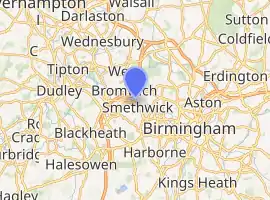Summit Bridge, Smethwick
Summit Bridge is a road bridge over a canal, built in 1789. It crosses the Old Main Line of the Birmingham Canal Navigations in Smethwick, in the West Midlands, England; it was part of John Smeaton's improvements to the canal system at its highest point in the area.
Summit Bridge | |
|---|---|
 | |
| Coordinates | 52°30′10″N 1°58′41″W |
| OS grid reference | SP 0158 8943 |
| Carries | Roebuck Lane |
| Crosses | BCN Old Main Line |
| Heritage status | Grade II* listed |
| History | |
| Designer | John Smeaton |
| Construction end | 1789 |
| Location | |

| |
It is a Grade II* listed building, listed on 8 February 2007.[1] It is also a scheduled monument.[2]
History and description
Summit Bridge was built in 1788–79, as part of a project carried out by John Smeaton to deal with the water shortages at the summit level, and to deal with traffic congestion by reducing the number of locks along the canal. By cutting through the hill, the summit level was reduced from 492 feet (150 m) to 472 feet (144 m). Summit Bridge was built to carry Roebuck Lane across the cutting.[1][3][4]
The bridge has a single span; it is built of red brick, with brick coping. On the north-west face there is a cast-iron plaque bearing the date "MDCCXC" (1790). The canal towpath is on the south-west side.[1]
A short distance to the south, Galton Bridge carries Roebuck Lane over the New Main Line, the adjacent canal built by Thomas Telford in the 1820s.[3]
References
| Wikimedia Commons has media related to Summit Bridge, Smethwick. |
- Historic England (8 February 2007). "Summit Bridge (1391875)". National Heritage List for England. Retrieved 27 October 2018.
- Historic England. "Smeaton's Summit Bridge (1005903)". National Heritage List for England. Retrieved 2 September 2019.
- Birmingham Canal: Historical Information Inland Waterways Association. Retrieved 28 October 2018.
- A P Baggs, G C Baugh and Johnston D A, "Smethwick: Communications", in A History of the County of Stafford: Volume 17, Offlow Hundred (Part), ed. M W Greenslade (London, 1976), pp. 96–98 British History Online. Retrieved 28 October 2018.